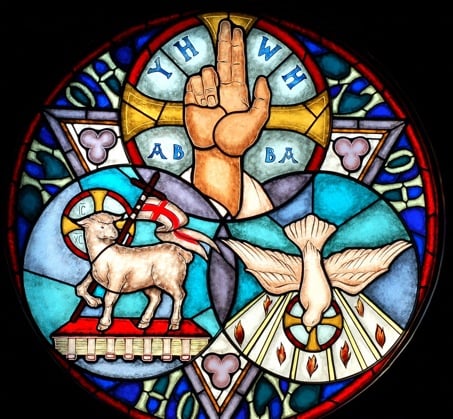The Lily Pond

In the previous page I introduced the Water Lily, hexagon 2977 inscribed with three nested sequences of hexagons and hexagrams, emerging from an iterative process that grows a fractal Star of David within a hexagonal frame. The figure resembles a real water lily on a lily pad, a parallel that extends to the pattern of geometric growth shared by the Template and water lilties (and many other plants) in their vegetative stage. Plant life also embodies fractal geometry, as does the Water Lily.
The New Bible Code makes use of fractal geometry stemming from G-triangles as a visual metephor for life and growth, as detailed in The Garden, The Creation Snowflake and other pages. The Water Lily is the last and most all-encompassing geometric metaphor, containing within itself the basic template for much of the geometry already displayed in these pages and for all the geometry that follows - an entire lily pond of pads and flowers, all pointing through gematria to Jesus Christ, the Gardener and the way to life.
The Template
Here is the Template for reference. For clarity, each inscribed hexagon and hexagram (and their centred-triangle equivalents, star hexagrams and star hexagons) are shown in outline.
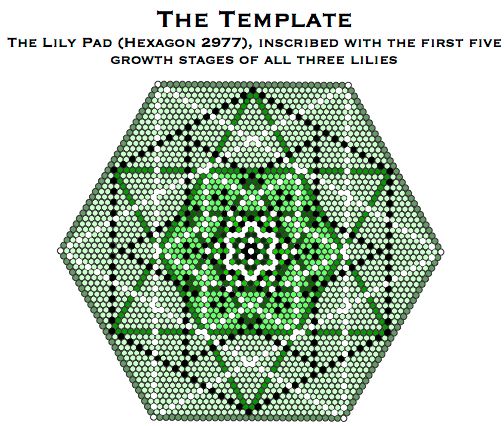
The Template derives from the simplest possible iterative method of growing hexagram/hexagon pairs from a single counter, which I described in the previous page. Each name and title displayed here is thereby linked not just to a number but to the geometry of G-triangles - in particular the Star of David, trefoils and snowflakes - and the related concepts of life and growth.
These are the pads and flowers in our lily pond.
Jesus Christ and Jesus the Messiah in English
First we consider standard values.
The first and one of the finest water lily flowers is the standard value of 'Jesus Christ', displayed in the previous page. Here it is again.
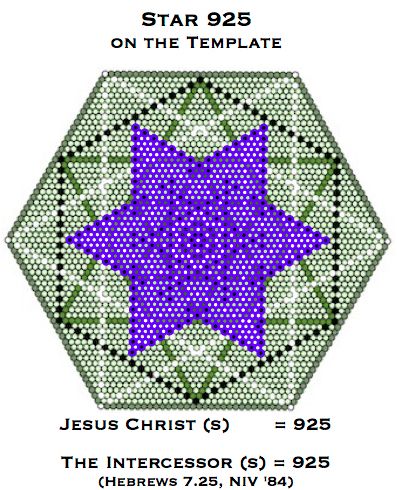
Star hexagram 925 is generated by the self-intersection of centred triangle 694. This is the standard value of two biblical titles for Jesus.
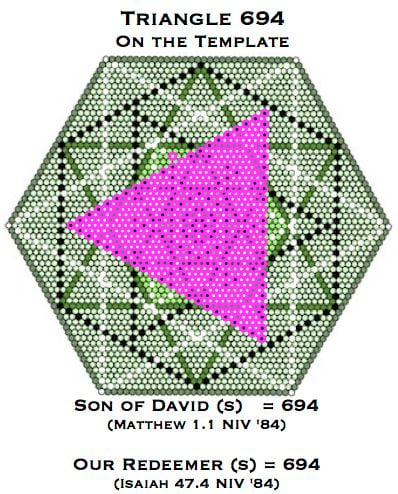
A closer translation of the Lord's Hebrew name and title, Yehoshua HaMashiach, is 'Jesus the Messiah'.
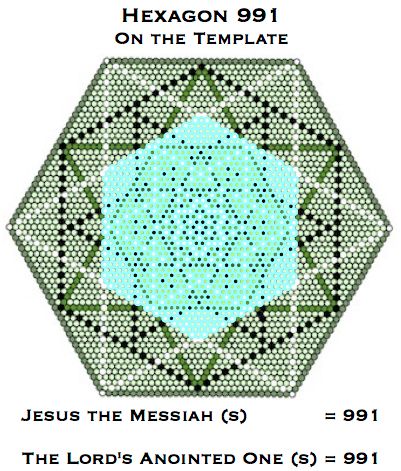
'Messiah' means 'anointed'! Further related titles are found as figures that can be cut from this star hexagon.
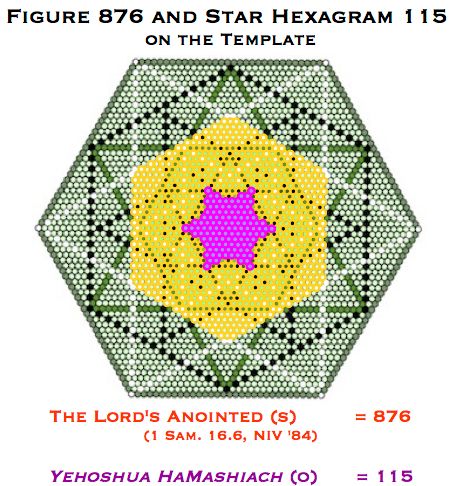
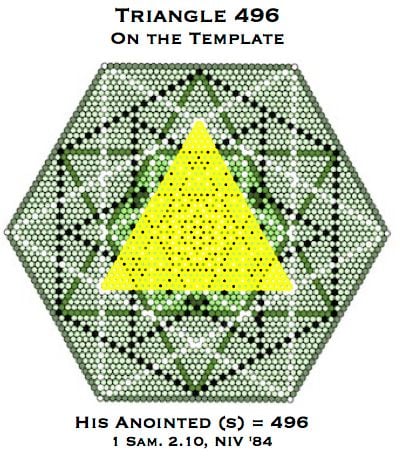
Each vertice of the triangle touches a vertice of star hexagon 991, therefore the triangle is precisely centred within it.
The entire Lily Pad is in fact composed of 6 x triangle 496 surrounding the central counter:
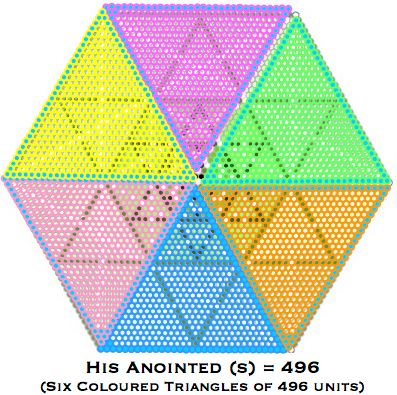
Star hexagon 991 also hosts centred triangle 361. Two further titles are linked to this number.
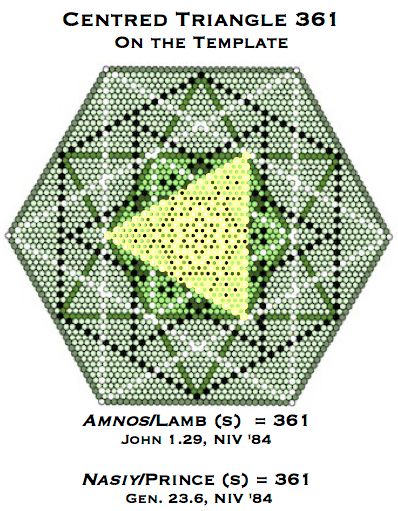
If we now merge the two stars representing 'Jesus Christ' and 'Jesus the Messiah' we create a double star, related to two important biblical titles given the Lord.
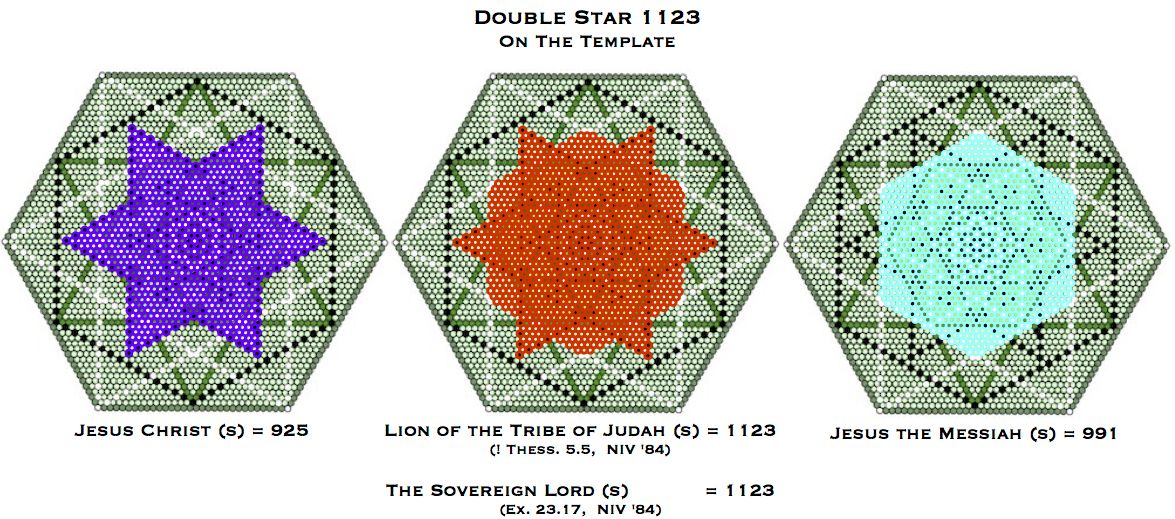
The number 1123 is a concatenation of the first four terms of the famous Fibonnaci sequence, which runs, 1, 1, 2, 3, 5, 8, 13, 21 . . . ., and from which the irrational number phi (the Golden Section) can be derived. [1] References to fundamental numbers and mathematical sequences are scattered throughout the code (see Irrational Encryptions, Divine Proportions and elsewhere for more examples).
The trancendenal number pi has also been woven into the gematria of Jesus Christ, through the simple division of the standard value of the Greek Ihsous Christos/Jesus Christ (2368), by the standard value of the Hebrew Yehoshua HaMashiach/Jesus the Messiah (754).
2368/754 = 3.140583 . . .
pi ............= 3.141592 . . .
This is a fair approximation of pi (only 0.03% too low), which is more accurate than the well-known approximation 22/7 (0.04% too high). [2]
This brings me now to those biblical languages.
Jesus Christ in Greek and Hebrew
The number 2368 is a double cubic shell, found by subtracting cube 1728 (12 cubed) from inside cube 4096 (16 cubed). The 2D projection of the cubic shell along an internal diagonal is hexagon 721, which is the lily pad formed by the first four iterations of the growth sequence. [3]
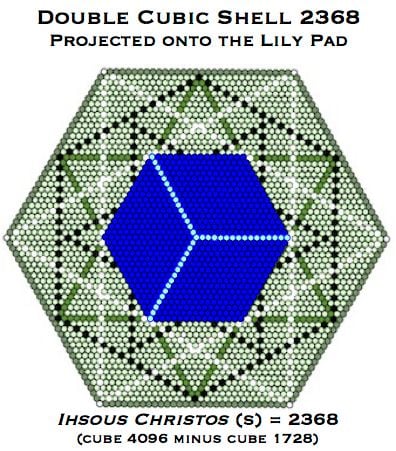
The 2D analogy of removing a cube from within another cube is the removal of a hexagon from within a larger hexagon. When the hexagon projected by cube 1728 is coloured within hexagon 721 on the Template we create the standard values of 'the Ark' and 'the Lord'.
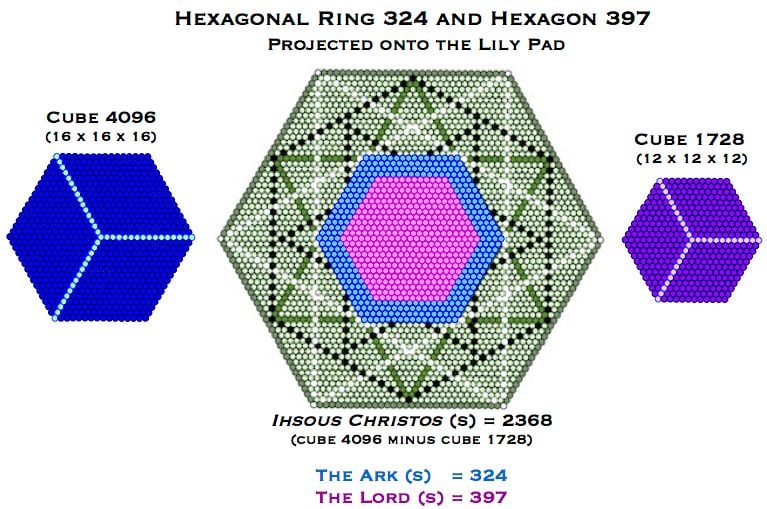
The Ark, its structure and contents, the rite of atonement and the Ark as an egg fertilised on 9/11 are the major underlying theme of the New Bible Code. See for example the The Day of Atonement, Glorious Geometry and The Male Child.
The number 754 is a trefoil composed of three joined hexagrams of 253 counters. This trefoil can be fitted onto the Template too, because it fits neatly inside a hexagon delineated by the outermost intersection points within the Template. There are several points of intersection between inscribed figures. The outermost intersection points are those found between star hexagram 1987 and star hexagon 2071. These delineate hexagon 1951 (outlined in red), which encompasses trefoil 754. Hexagon 1951 is the 26th in the sequence, 26 being the ordinal value of 'God' and the standard/ordinal value of YHVH/The LORD.
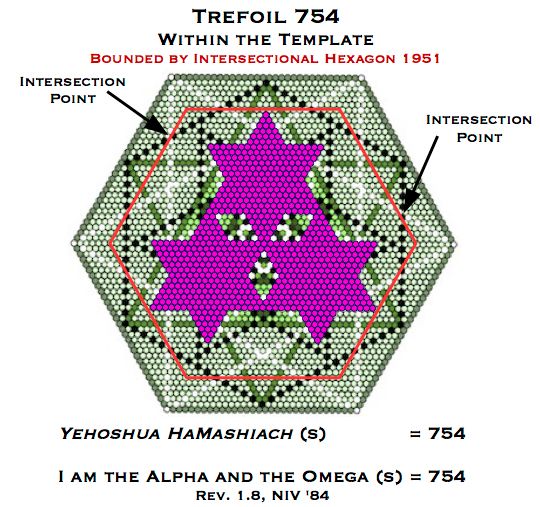
So the G-triangle geometry forming the Template holds the standard values of the names 'Jesus Christ' and 'Jesus the Messiah' in biblical Hebrew, biblical Greek and modern English, reflecting the Hebrew Bible (Biblia Hebraica Stutgartensia), the New Testament (Textus Receptus) and the 1984 NIV Bible.
The ordinal and reduced values of all these names, again in English, Greek and Hebrew, are all found on the Template too, as displayed below. Note that the figures on the right in rows 1 and 3 are double snowflakes, formed by the merger of the first two figures on each row.
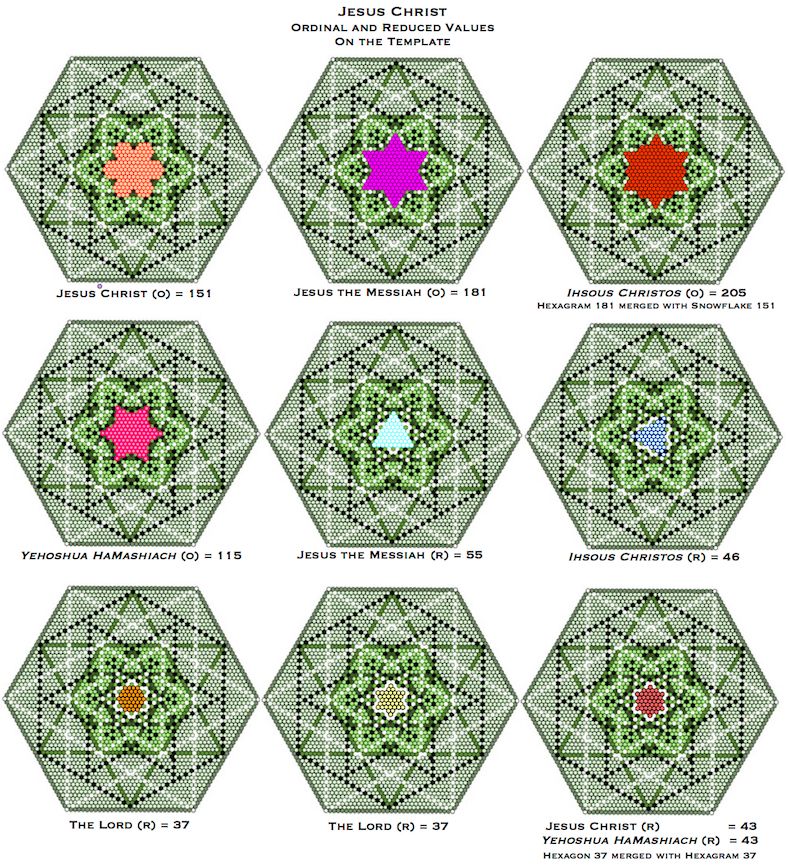
The Word
Jesus is also known as the 'Word' (John 1.1), the standard value of which is found by subtracting hexagram 337 from star hexagon 991, representing 'Jesus the Messiah'.
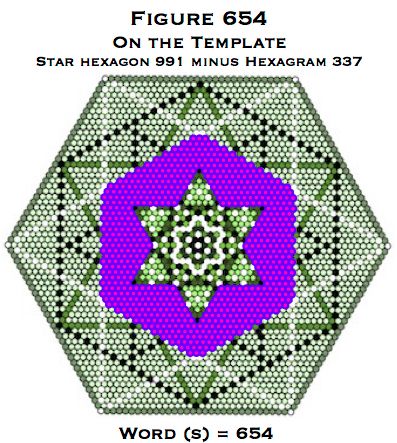
The same number can be derived from star hexagon 925, representing 'Jesus Christ', this time by the removal of a central (and intersectional) hexagon.
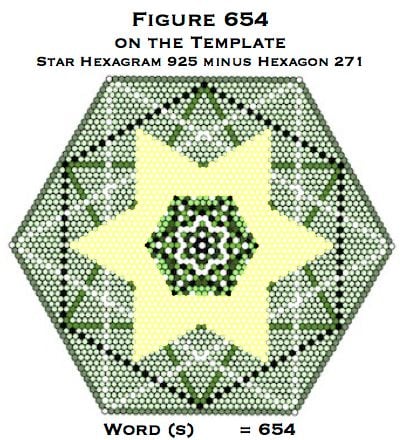
The dual hexagon/hexagram reflectivity linked here and elsewhere with the Second Person of the Trinity will be revisited, but for now consider the following pair of identities:
Hexagon (o) ..= 74 = Jesus (o)
Hexagram (o) = 77 = Christ (o)
Hexagram 337 is the first step in an iterative process, starting with triangle 253, that can be taken two steps towards the fractal known as the Koch snowflake. The second step creates snowflake 373, a stunning crystalisation of the famous Greek designation for Jesus Christ: logos.
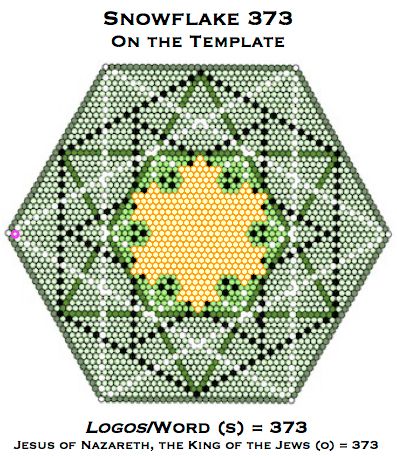
This version of the Superscription is from John 19.19 and John's gospel is the very book that introduces the logos!
Growing from hexagram 337 on the Template, snowflake 373 also fits tightly into Star of David 925, each point touching the outline of the figure. The geometric link between 'Jesus Christ' and 'logos' is sealed by the addition of further internal structure.
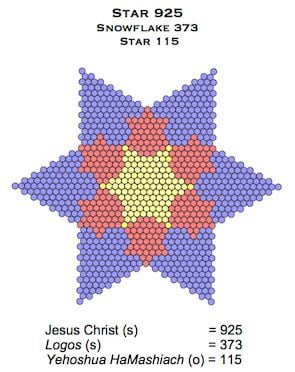
English, Greek and Hebrew combine here to create a miracle of gematria, each internal snowflake precisely fitting into its parent figure.
Star hexagram 115 was shown earlier along with the ordinal value of 'Jesus Christ', 151. Antisnowflake 151 is the first iteration of a hexagonal Koch antisnowflake, which crystalises within snowflake 373 during the growth of the Creation Snowflake. Also created at the very centre is hexagram 37, reduced value of 'the Lord'. Here, then, is a second sequence of nested snowflakes, each representing the Lord in number and form, this time with the Lily Pad in the background so you can see how perfectly the fractal snowflakes fit onto its Template.
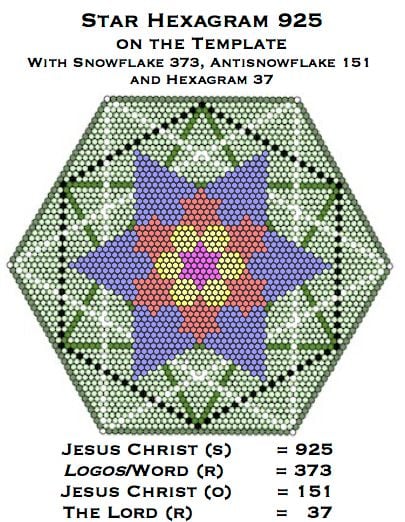
Finally, in Hebrew, 'the Word' is Ha Davir. This is also represented on the Template along with the Greek logos once more, both figures derived from the trefoil of hexagrams that represent Yehoshua HaMashiach and bearing its mark. These derivative figures proclaim, as do others shown earlier, that Jesus is the Word made flesh.
Star hexagram 1303 touches the outline of intersectional hexagon 1951. From it can be derived figures representing 'Word', 'the Word' and Davir/'Word'.
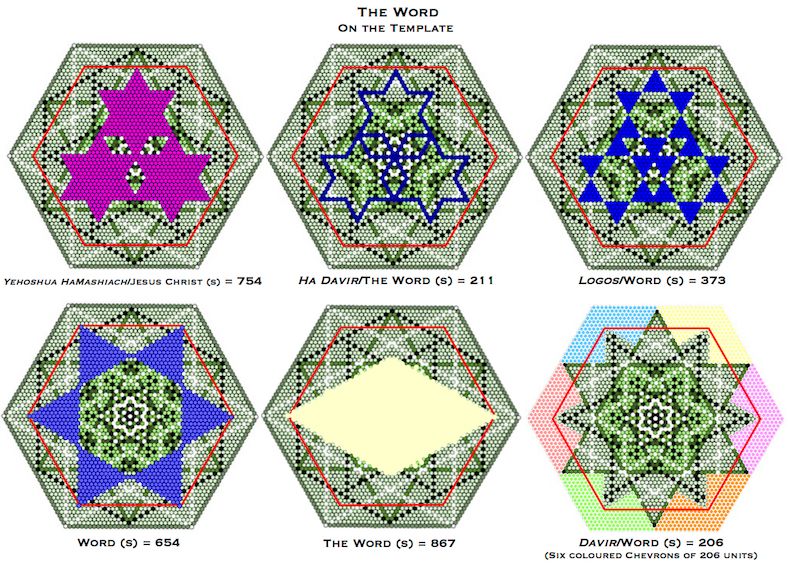
To witness 'Jesus', 'Word', Yehoshua and 'Messiah' encoded together in the NIV Bible's opening words, see The Signature of Christ. [4]
The Second Coming
The New Bible Code exists to announce the Second Coming of Christ. This long-awaited event is loudly proclaimed by a matching pair of water lilies, which consciously reflect each other to deliver the message in stereo.
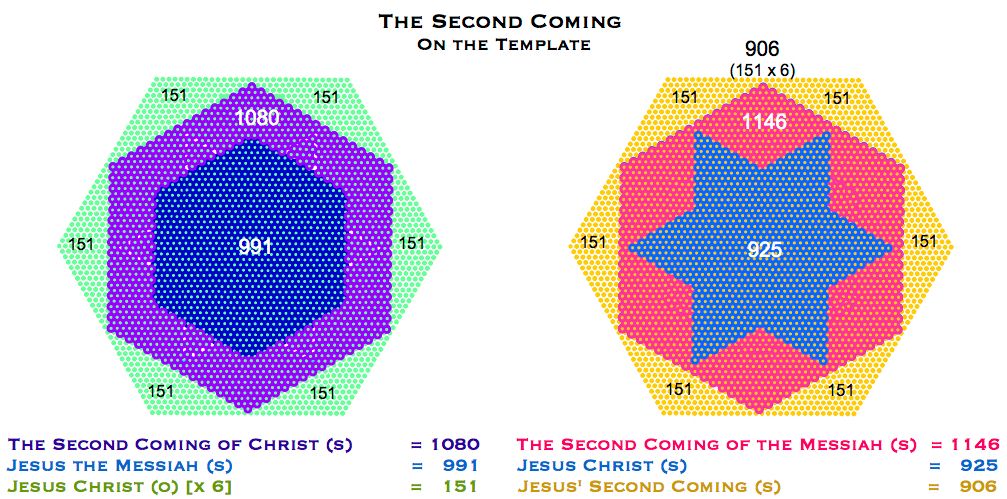
These self-reflective symbols of the Second Coming are all found in a tight trio of encodings within three word-strings, beginning on the NIV Bible's first, second and third words!

For more word blocks proclaiming the fact that the Second Coming is now upon us please see Footprints in the Sand.
Summary
Our pond is now well stocked with water lilies, each 'phenotype' developed and grown by a Gardener of awe-inspiritng creativity and loving concern for His Creations. There are so many water lilies representing Jesus that I can't hope to display them all, but his formal names and titles are all found on the Template and displayed on the Lily Pad on this page, as I believe was intended.
These Water Lily encodings also display patterns that announce Christ's Second Coming with the same gusto as the rest of this magnificent taperstry of meaning.
In the next page I display more water lilies corresponding to the first and third Persons of the Trinity.
Bill Downie 27/6/20
Notes
1. Any term in the sequence can be divided by the previous term to give an approximation of phi (1.618033 . . . ). Early terms give very crude estimates, but the accuracy improves very quickly. So 3/2 = 1.5, but 21/13 is 1.615 . . . .
2. Dividing one whole number by another can never give exactly pi in any case.
3. The connection between hexagon 721 and cubic shell 2368 is like a dotted line rather than a solid one, the more so because hexagon 721 is also the projection of cube 4096 itself. However, I have found several other important examples, which strengthens the link and is how gematria in general works: YHVH/The Lord (s) = 26, the shell of cube 27 (3 cubed); Yehoshua/Jesus (s) = 386, the outer shell of cube 729 (9 cubed); Jesus of Nazareth (s) = 1736, the outer shell of cube 5832 (18 cubed).
4. The New Bible Code is now slowly being erased within the NIV Bible, due to ongoing revisions, but this part will remain for a very long time.
